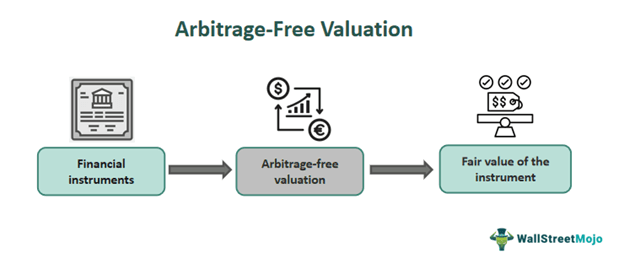Table of Contents
What Is Arbitrage-Free Valuation?
An arbitrage-free valuation is an approach that determines bond values based on the assumption that no arbitrage opportunities exist. Violations of the law of one price give rise to arbitrage opportunities. There are two types of these opportunities: value addition and dominance.

This approach differs from the traditional valuation approach, which uses a single interest rate to discount all bond cash flows. By adopting this approach, investors can obtain a more accurate estimate of the fair value of a bond, aiding them in making well-informed investment decisions.
Key Takeaways
- Arbitrage-free valuation assesses bond values under the premise that there are no arbitrage opportunities.
- Arbitrage involves purchasing security from one platform, exchange, or location and subsequently selling it on another.
- In this valuation technique, financial instruments are valued according to the risk attached to them and their underlying cash flows.
- The financial sector employs the valuation approach to ensure that financial instruments are priced appropriately.
- Leaving no room for arbitrage opportunities is considered positive as they can lead to price distortion, destabilize the market, and produce inefficiencies.
Arbitrage-Free Valuation Explained
The arbitrage-free valuation approach for Treasury bonds is based on the principle that the value of a bond (spot rate or current market value). This value should equal the sum of the present values of all its cash flows. The financial sector employs this technique to ensure that financial instruments are priced appropriately. Eliminating arbitrage opportunities is considered positive as they can lead to price distortion, destabilize the market, and produce inefficiencies.
The arbitrage-free valuation framework applies to all types of financial assets, including interest-rate swaps and zero-coupon bonds. Given that the yield curve typically isn't flat, it's essential to use appropriate spot rates to discount each bond's cash flow. Doing so ensures that the bond is correctly priced according to its underlying cash flows, which leads to an arbitrage-free value.
This valuation approach takes the security values present without arbitrage opportunities. Arbitrage is the process of buying a security from one platform, exchange, or location and selling it on another platform, exchange, or location. The investor gains profit from the difference in the security value due to different selling places. When such conditions are absent, all markets have similar price ranges without discrepancies.
In this technique, financial instruments are valued according to the risk attached to them and their underlying cash flows. The strategy considers interest rates, the yield curve's structure, and other market variables that may impact the value of the security instruments. By evaluating financial assets in this way, investors can get a more precise idea of their fair value and make smart investment choices. In addition, it ensures that financial markets are efficient and that the security prices reflect the true economic reality, giving us a picture of transparent markets.
Examples
Let us consider some examples to understand the concept better:
Example #1
Let's take the example of Dan, an investor who wanted to find out the arbitrage-free value of a bond of XYZ institution. He noted down the following steps to aid the evaluation:
Step 1: Estimate future cash flows associated with the bond.
Step 2: Establish the proper discount rates for each cash flow.
Step 3: Determine the present value of the anticipated future cash flows by utilizing the proper discount rates chosen in Step 2.
Example #2
Many events led to the 2008 depression over a long period. The mortgage loan crisis was a significant issue and invariably destroyed economies. The issue of mortgage-backed securities (MBS) was increasingly getting worse during the period. The subprime mortgages based on MBS lost value and negatively affected the bank and investment firm portfolios. The MBSs from the U.S. housing market have been bought and sold in other country exchanges, especially in Western Europe, where they were experiencing their housing crisis.
Even for the banks that owned them, evaluating the health of bank portfolios holding MBS assets was challenging due to the complexity of MBS. This was because MBS were sometimes sold in fragments, combined with other loans. Then, it is resold in capital markets as new securities, making it difficult to ascertain the actual worth of the underlying assets. This made it challenging for banks and investors to appropriately measure the risk connected with MBS, which aided in the 2008 financial crisis.
The issue here was arbitraging. It grew out of hand and contributed to the downturn of the economy. As a result, investors and regulators started concentrating more on adopting the arbitrage-free valuation technique to price these securities fairly. They could recognize pricing errors and lessen their risk exposure by doing this. Investors could also evaluate MBS-like securities more accurately and make wise choices.
Applications
This valuation approach has a wide range of applications in the finance industry, including:
- It helps in estimating bond prices. This can be done through the timing and shape of the yield curve. The prices of options and other securities can also be determined similarly.
- It can aid investors in better comprehending the risks connected to their assets, which can help control those risks. Individual investors, financial firms, and institutional investors may find this information helpful since it can help them better manage their portfolios and lessen their exposure to potential losses.

